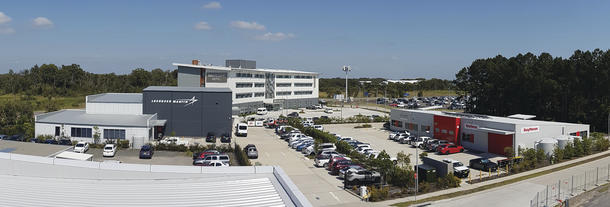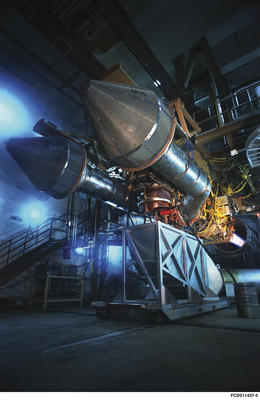With the first Australian F-35As due to arrive in December 2018, work is continuing apace to prepare facilities and systems for the fifth generation fighters. ADM spoke with some key people, including JSF Division head AVM Leigh Gordon, for an update on progress.
Patrick Durrant | Sydney
In May 2015 the first sod was turned on the $1.5 billion New Air Combat Capability (NACC) facility works at RAAF Base Williamtown. Under the project, the largest public works activity undertaken since WWII, both RAAF Bases Williamtown and Tindal will be transformed as they are readied for the arrival of the first F-35As.
The works at Williamtown, home to the first two squadrons to operate the F-35 (Nos. 3 and 77), will account for about $1 billion of the total. The new facilities will include an F-35 training complex for No. 2 Operational Conversion Unit (OCU), a combined 3 and 77 Squadron headquarters facility and hangars, off-aircraft component maintenance facility, off-board information systems centre (OBISC) to manage software updates and equipment preparation, new parking aprons, a deeper level maintenance facility and a centre for testing and painting the aircraft’s surface finish to maintain its low radar observability.
“Recently, I was lucky enough to go and stand atop the No.2 OCU building and look out across the expanse of the F-35 facility and it is quite amazing,” AVM Gordon told ADM.

Industry is expanding its presence at RAAF Williamtown. Credit: Lockheed Martin
He explained that the building is at an advanced stage of construction, with those for the squadrons also rapidly taking shape. Explosive ordnance storage facilities have already been moved and the work on the runway extension is close to completion.
“They’ve done a lot of preparatory work for the aircraft hardstands, you can now see where it’s laid out and where they’ll be building up the surface and putting the paving down,” he said.
The work on the runway extensions has been undertaken with the consideration that Williamtown will support two operational and one training squadron, and AVM Gordon explained this examined operational squadrons flying the F-35 at higher weight and also the fact it occasionally will be operated by pilots during their conversion training, when they will naturally be less experienced with the type.
“We really need that length of tarmac to allow pilots to be able to make the right decisions in the event of something happening,” he said. “So there’s a real safety piece to those extensions.”
Under normal operating circumstances, he didn’t envisage the aircraft requiring afterburner for take-off.
The first building at a point where it can be occupied is the OBIS Centre. Vital to the effective introduction of the F-35s and future sustainment efforts is the Autonomic Logistic Information System (ALIS); it will be home to the imminent risk mitigation activities that have been planned to test the system and its integration into the Defence information environment. The first issue of the ALIS standard operating unit has been delivered and Defence IT personnel are preparing to install it in the new building.
“In the first quarter of 2017, we expect to have all of the computer systems installed in that building and we’ll be able to start the process of testing the interchanges and working out how ALIS works in conjunction with our networks, so that will be a pretty important step in the project,” AVM Gordon said.
He’s proud of the fact that Australia has specifically taken this step which will contribute towards mitigating risk in the program.
“I think there’s a lot of sense behind it and the preliminary work we do now will pay dividends further down the track.”
Program concerns
In September last year, the Pentagon’s chief weapons tester, Director of Operational Test and Evaluation (DOT&E) Dr Michael Gilmore sent a memo to the US F-35 Joint Program Office (JPO) highlighting his concern that the aircraft’s full warfighting capability software release (Block 3F) would not be ready as scheduled, in turn delaying the aircraft’s readiness for Initial Operational Testing and Evaluation, set for August 2017. Dr Gilmore called for the program to be restructured and for additional resources to deliver the full Block 3F warfighting capability.
AVM Gordon is not overly concerned by this, citing the different timeframes for Australia’s F-35 program (IOC December 2020).
“The US Air Force declared IOC for its F-35As in August of last year so that’s an example of the schedule contingency we’ve got between the two,” AVM Gordon explained to ADM.
Of course he’s keen to see OT&E completed as soon as possible and is reassured by the presence of Australians working at the USAF’s flight test centre at Edwards Air Force Base in California as part of the Joint Operational Test team.
“I’d like to see it tied up – then we can capture the lessons out of that activity and flow them into the follow-on modernisation program.”
RAAF Base Tindal, home to 75 Squadron (the last to be equipped with the F-35) will pass a significant milestone in March with a design review setting the basis for the work to occur after that. As with Williamtown, which is also undergoing a significant base redevelopment alongside the NACC work, everything needs to be done with no capability impact.
Regional MRO
In February 2015, BAE Systems Australia was assigned responsibility for regional Maintenance, Repair, Overhaul and Upgrade (MRO&U) for the F-35 airframes in the Southern Pacific. Similarly, TAE was awarded responsibility for MRO&U for the F-35’s F135 engines from Pratt & Whitney.
 BAE Systems F-35 campaign lead Andrew Gresham said the company had completed a 50 per cent design solution for its F-35 airframe MRO&U site at Williamtown. In December last year, a design review for the site activation was conducted in conjunction with AVM Gordon’s JSF Division, the JPO and Lockheed Martin Aeronautics.
BAE Systems F-35 campaign lead Andrew Gresham said the company had completed a 50 per cent design solution for its F-35 airframe MRO&U site at Williamtown. In December last year, a design review for the site activation was conducted in conjunction with AVM Gordon’s JSF Division, the JPO and Lockheed Martin Aeronautics.
“Early this year we’ll have the facilities infrastructure design to a point where we’ll be ready to go into sub-contracts for construction stage,” Gresham said to ADM. “That’s the first point where it really starts to take shape, there’ll be activity on the BAE Systems site where it starts to transform and look like an F-35 airframe facility.”
BAE Systems is aiming to stand up the initial capability for the airframe facility in December 2018, in order to align for the arrival of the first aircraft.
In November last year, the company was one of a group, including Northrop Grumman, GE and RUAG, selected to perform MRO&U on 64 of the first 65 F-35 components to be assigned for regional work.
The support work for the Pratt & Whitney F-135 engines will be performed by TAE. Credit: Pratt & Whitney
“Starting in 2021, we will start to support the global volumes for the life support systems which are primarily the oxygen components in the ejector seat,” Gresham explained. “We’ll repair the global volumes for those through to 2025, at which point all of the regional repair capability will be stood up for the Pacific region – that’s when all of us will start repairing the 64 of those 65 components.“
From mid-2017 there will be a competitive tender to outsource the regional MRO&U of another 700-odd components in the tier 2 list. Gresham said the company was working closely with the Commonwealth, JPO and other local industry partners to determine how they could best improve their offerings for the additional work.
“We’re looking to secure as many of those additional components as we can because that’s the way you can really drive the benefits for industry, the Air Force and regional operators via cost synergies for the additional volumes.”
Australian content
AVM Gordon has been encouraged by the success of Australian companies in winning F-35 work to date, especially with regard to the component repairs. He explained that the airframes and engine work had to be a sovereign capability because the Commonwealth didn’t want the aircraft being maintained overseas.
“When Lockheed Martin, Pratt and Whitney and the JPO came out to look at the facilities for assignment, they recognised the strength of the BAE Systems facility and also the TAE facility in that offering, such that they could effectively be assigned the responsibility for the Southern Pacific region. They’ve got this view that on airframes and engines Australia could do more work than just the Australian component.”
However, for the component assignments, the Commonwealth preferred to support local industry winning the work based on merit.
“This is what has occurred, and the assignments mean they are now able to work through the US JPO to develop appropriate contracts with Primes and Original Equipment Manufacturers against the likely scope of work,” AVM Gordon said.
“There will be a level of work with which they can be established and then it’s really up to the venues to commercially win more.”
“Recognising that we are three to five years before full tempo F-35 operations will be occur in Australia, it’s really an opportunity for them to be on a journey with industry to ensure that they have the appropriate arrangements in place to support that.”
With Japan also supplementing the F-35 MRO&U workload for airframes and engines from 2018 and 2021 respectively (for the Northern Pacific), AVM Gordon said eventually the organisation within the system that can provide the best value outcome to the joint enterprise would get more work. Given the geographical distance separating the two, this is more likely to occur for engine maintenance, where components could be worked on separately and transported more easily.
“The same model will apply for the other F-35 components. There will be a level of work with which they can be established and then it’s really up to the venues to commercially win more work from the global system,” he said.
Sustainment
The JSF Division chief’s biggest priority now is delivering a capability that will prevail throughout its whole of life.
“It’s not just about a couple of jets in Australia in 2018; we need to be setting up a system that will operate effectively for the next 35 years. That means a sustainment system that will support the aircraft, a training system that will accommodate the capacity, and a process of follow-on modernisation through the international partnership that will enable the aircraft to remain relevant throughout that period.”
He cites the division’s work with BAE Systems on a potential RF seeker for the F-35’s Joint Strike Missile as an example of the latter.
Another priority includes making sure there is appropriate engagement with the international partnership, industry and Defence to guarantee delivery of a successful capability.
“Also taking care to link up the F-35 industry program with the Defence Industry Policy Statement and the reforms that First Assistant Secretary for Defence Industry Policy Kate Louis’ team is bringing forward.”
As the clock ticks on the biggest, most transformational program in the Air Force’s history, AVM Gordon relishes the excitement of the job.
“There’s so much going on with the program, even a month feels like an eternity in the F-35 world.”
This article first appeared in the February 2017 issue of ADM.





